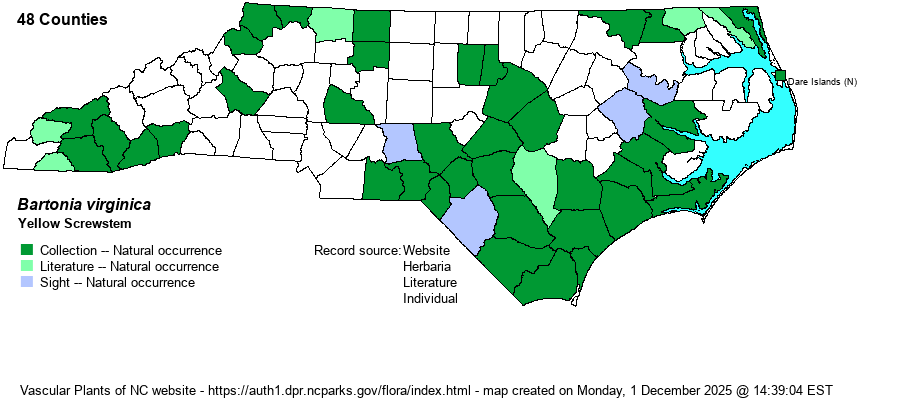| Author | (L.) Britton, Sterns, & Poggenburg | |
| Distribution | Scattered across the state, but with many gaps. Small and easily overlooked, especially if not in bloom. Most widespread in the southern half of the Coastal Plain, especially in the southeastern portion and in the Sandhills region, particularly where Longleaf Pine (Pinus palustris) wetlands are present.
This is a widespread Eastern species, occurring over eastern Canada south to southern FL and LA. It is more numerous from VA northward than in Southern and Mideastern states.
| |
| Abundance | Fairly common in much of the southern Coastal Plain, though more so in the southeastern counties and in the southwestern ones (Sandhills). Rare to uncommon in the northern half of the Coastal Plain. Rare to locally uncommon in the Mountains, but mostly rare in the Piedmont. Thus, less numerous in the Piedmont than in either province to the east and west. It is the only one of the three Bartonia species in the state not on the NCNHP's Watch List. | |
| Habitat | This is a wetland species of acidic soil, like the other two Bartonia species, and its habitats overlap those, especially with B. paniculata. It grows in wet spots and openings in pine savannas, seepage pocosins, pocosin edges, margins of pineland pools, in bogs, dune swales, and openings in swamps. | |
| Phenology | Blooms from July to October, and fruits shortly after flowering. | |
| Identification | This is a wiry, filamentous-stemmed herb growing in an erect manner to about 8-12 inches tall. Thus, it is usually shorter and more erect than is B. paniculata, which can often lean or twine. As with the other two screwstems, this species has only scale leaves along the stem, but these are essentially all opposite, though you may have to get on hands and knees to see this! The leaves of B. paniculata are usually alternate. The top several inches of the stem hold the inflorescence, which consists of a narrow raceme or some very short and ascending branches with flowers in a narrow panicle. Each flower is nearly identical to that in B. paniculata, being only about 1/5-inch tall, with the pale yellowish or greenish-white petals erect and almost "closed", with the opening facing upward. An average plant may hold 10-15 flowers. As with the other two screwstems, at normal standing height, you can spot the pale greenish or pale yellowish "blobs" of flowers without spotting the stem at all. This is certainly more numerous than the other two Bartonia species in the state, and you have a decent chance of seeing it in late summer in some of the well-managed pine-dominated natural areas in the southern part of the Coastal Plain. A number of montane bogs also hold this species, though most of them are off-limits to the public. | |
| Taxonomic Comments | None
| |
| Other Common Name(s) | Yellow Bartonia | |
| State Rank | S4 | |
| Global Rank | G5 | |
| State Status | | |
| US Status | | |
| USACE-agcp | FACW link |
| USACE-emp | FACW link |

